#reptile fossil
Explore tagged Tumblr posts
Photo

Genuine Rebbachisaurus Dinosaur Tooth Fossil Cretaceous Kem Kem Morocco COA
Authentic Fossil Rebbachisaurus Dinosaur Tooth – A Rare Cretaceous Marvel
This rare and genuine Rebbachisaurus dinosaur tooth is a captivating piece of history from the Kem Kem Beds of the Tegana Formation, located in the Kem Kem Basin, Morocco. Dating back to the Aptian stage of the Cretaceous period, this fossil represents a unique sauropod species known for its long neck and herbivorous diet.
Key Features:
Species: Rebbachisaurus (Sauropod Dinosaur)
Geological Formation: Kem Kem Beds, Tegana Formation
Age: Aptian, Cretaceous (~113-125 million years old)
Location: Kem Kem Basin, Morocco
Condition: 100% Genuine Fossil
Certificate of Authenticity: Included with every purchase
Why Choose This Fossil?
Unique Specimen:��The tooth shown in the listing photos is the exact fossil you will receive. Carefully chosen for its remarkable preservation and quality, this piece is a standout in any collection.
Scale Reference: Includes a 1cm cube in the photos to provide precise size context. See images for full measurements.
Professionally Prepared: Cleaned and stabilized by experts to ensure long-term durability and display quality.
About Rebbachisaurus:
Rebbachisaurus, a genus of sauropod dinosaurs, lived in what is now North Africa during the mid-Cretaceous period. Known for its massive size and elongated neck, Rebbachisaurus was an herbivore that thrived in lush environments. Its fossil remains provide crucial insights into the diverse ecosystem of the Kem Kem Basin during this era. Teeth like this were essential for stripping foliage from trees and other vegetation, enabling this gentle giant to sustain its enormous body size.
Perfect for Collectors and Enthusiasts
This Rebbachisaurus tooth fossil is ideal for anyone passionate about dinosaurs, paleontology, or natural history. It also makes an excellent gift for collectors and history buffs alike. A true centerpiece that highlights the fascinating story of Earth's ancient past.
All of our fossils are 100% genuine and come with a Certificate of Authenticity. We guarantee that you’ll receive a high-quality specimen, carefully selected and prepared for your enjoyment.
Fast and Secure Shipping: Your fossil will be packed with great care to ensure it arrives safely at your doorstep.
Don’t miss your chance to own a genuine Rebbachisaurus dinosaur tooth from the Cretaceous period. Add this extraordinary fossil to your collection today!
#fossil#fossils#reptile fossil#genuine specimen#specimen#genuine fossil#fossil tooth#dinosaur#raptor#fossilized tooth#dinosaur tooth#tooth
2 notes
·
View notes
Text

Act like Megalochelys atlas and smile, because it’s Fossil Friday! One of the largest known land turtles, scientists think this massive reptile could reach heights of 5.9 ft (1.8 m)—tall enough to look a grown human in the eye. This specimen’s shell measures some 7.4 ft (2.3 m) long and in life, it may have weighed more than 2,000 lbs (907 kg). Megalochelys lived during the Late Pliocene about 2 million years ago. The fossil on display in the Museum’s Hall of Vertebrate Origins was found in 1922 in Chandigarh, India.
Photo: © AMNH
#science#amnh#museum#fossil#nature#natural history#animals#paleontology#turtle#herpetology#did you know#fact of the day#pliocene#fossil friday#cool animals#turtles#smile#ancient animals#reptiles
2K notes
·
View notes
Text


Ancient Shell-Less Turtle Species Identified From 228-Million-Year-Old Triassic Era Fossil
Eorhynchochelys
(2018)
Scientists have discovered remains of a rare kind of turtle, one that lived over 228 million years ago in the Triassic era and had no shell – the most common feature of present-day turtles. The nearly complete skeleton of the ancient turtle was found by researchers from China's Institute of Vertebrate Paleontology and Paleoanthropology in the Asian country’s Guizhou province. The animal had a toothless beak and Frisbee-shaped body just like present-day turtles, but there were no signs of growing bones that form the shell. Modern turtles use the feature to enclose their vital organs, including the head in some cases, and protect themselves "This creature was over six feet long, it had a strange disc-like body and a long tail, and the anterior part of its jaws developed into this strange beak," Olivier Rieppel, one of the researchers involved in the work, said in a statement. "It probably lived in shallow water and dug in the mud for food." As no such turtle has been described in the books of science, the animal has been classified as a completely new species. It has been named Eorhynchochelys sinensis, which means the ‘Dawn turtle with a beak from China’...
Read more: Ancient Shell-Less Turtle Species Identified From 228-Million-Year-Old Triassic Era Fossil | IBTimes
#prehistoric#paleontology#fossils#turtle#evolution#turtle evolution#animals#nature#china#asia#reptile#herpetology#science
363 notes
·
View notes
Text

Today's random portfolio artwork is a life-size Diplodocus mural (human figure for scale), which I painted for the Children's Museum of Indianapolis.
#Art#Painting#PaleoArt#PalaeoArt#SciArt#SciComm#DigitalArt#Illustration#Dinosaurs#Birds#Reptiles#Palaeontology#Paleontology#fossil friday
1K notes
·
View notes
Text
So the last book I read gave me a great review of the evolutionary history of tetrapods. One particular group of tetrapods that may or may not have represented the earliest amniotes (animals with more advanced egg membranes) were the Diadectomorpha.
Now, keep in mind that these were really primitive creatures in the lineage that eventually led to mammals. If you look at the skeleton of a Diadectes, for example, you'll notice that the spine has lumbar ribs, which suggests that it likely hadn't yet evolved a diaphragm, which helps with breathing when moving at high speeds.

But wait--what is that SKULL?

This is the most cartoonish skull I have ever seen! I mean, the poor guy looks like T. rex's dorky, uncool cousin.

Look, I know Diadectes lived before amniotes began to evolve fenestrae (holes) in their skulls to make great places to anchor tendons and muscles for stronger and wider bites. I still wouldn't want to get bitten by this critter, but the first thing I legitimately thought of when I first saw this photo was...

So from now on whenever I picture a life restoration of Diadectes in my head, this is what I'm going to see in my head:

#Diadectes#paleontology#Reptiliomorphs#amniotes#reptiles#evolution#science#skulls#animals#wildlife#nature#fossils#extinction#paleoart#evolutionary biology#skeleton
70 notes
·
View notes
Text
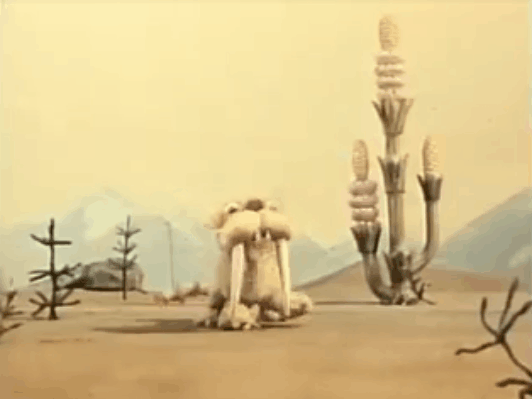



Vasya and the Dinosaur (Вася и динозавр)
Kievnauchfilm, 1971
#paleomedia#kinda wish there was a lot more prehistoric stuff from USSR they had a rich extensive fossil history esp permian stuff#stegosaurus#sabre tooth cat#mammoth#pteranodon#kievnauchfilm#70s#feline#elephant#dinosaur#reptile#pterosaur#puppet
130 notes
·
View notes
Text


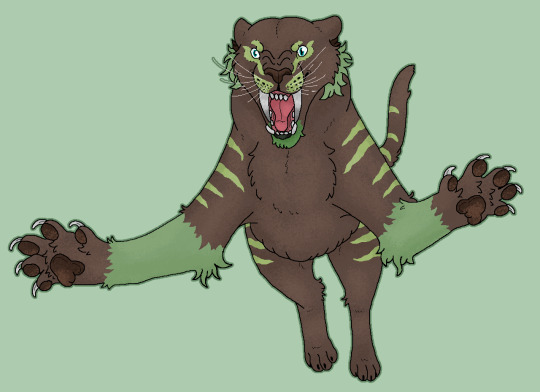







Last group of non-dinosaurs (besides Tryma...) for the first Fossil Fighters game! Onto Champions!
#fossil fighters#fossil fighters: champions#fan art#fanart#rhinoceros#brontothere#nimravidae#artiodactyl#cetacean#felid#elephant#gastornis#sloth#turtle#mammal#bird#reptile#brontoth#elasmoth#hoplo#andrarch#paki#smilo#mammoth#tryma#megath#chelon#and yes this is the hoplo from the poplo meme
48 notes
·
View notes
Text
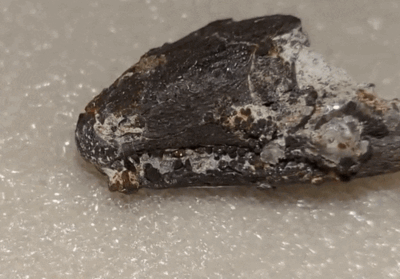
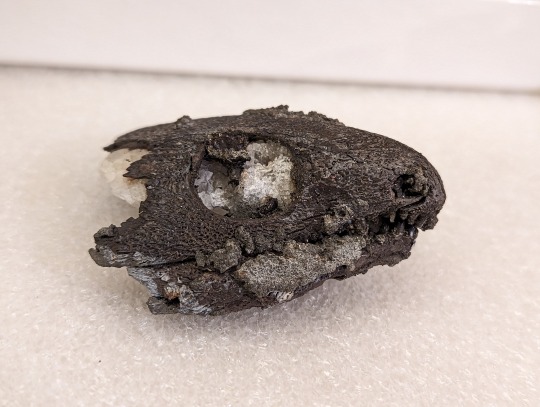
Captorhinus skulls with pyrite and calcite crystal growth.
Captorhinus were anapsids from the Permian - meaning their skulls did not have the normal fenestration that diapsid reptiles or synapsid mammals have. Named for their hooked snout, these reptiles had a pineal(or "third") eye - a small photoreceptive spot on the top of the skull not seen in the pictures here.
518 notes
·
View notes
Photo

Rare Metriorhynchus Crocodile Tooth Fossil, Jurassic Era, Oxford Clay, Bradley Fen, UK
Rare Metriorhynchus Crocodile Tooth Fossil – Jurassic Era, Callovian Stage, Oxford Clay, Bradley Fen, Whittlesey, Peterborough
This exceptional Metriorhynchus crocodile tooth fossil is a fascinating relic from the Callovian Stage of the Jurassic Period, approximately 166 to 163 million years ago. Discovered in the renowned Oxford Clay Formationat Bradley Fen, Whittlesey, Peterborough, this fossil offers a unique glimpse into the life of one of the Jurassic’s apex marine predators.
Metriorhynchus was a genus of marine crocodiles, uniquely adapted to a life in the ocean. Unlike their modern relatives, these crocodiles had streamlined bodies and paddle-like limbs, making them efficient swimmers. Their sharp, conical teeth were perfectly suited for catching fish, squid, and other marine prey. Fossils like this tooth are highly sought after for their scientific importance and connection to the ancient ecosystems of Jurassic Britain.
Features:
Species: Metriorhynchus (Marine crocodile)
Era: Jurassic (~166–163 million years ago)
Stage: Callovian
Formation: Oxford Clay Formation
Location: Bradley Fen, Whittlesey, Peterborough, UK
Condition: Excellent preservation with detailed tooth structure and natural enamel visible.
Size: Refer to the scale cube in the photo for precise measurements.
This fossil has been professionally cleaned and prepared to highlight its intricate features while preserving its natural authenticity. It is a valuable addition to any fossil collection, educational display, or museum exhibit.
Why Buy From Us?
100% Genuine Specimens: All fossils are handpicked and guaranteed authentic.
Certificate of Authenticity Included: Your purchase comes with a certificate verifying the fossil’s origin and authenticity.
Exact Specimen Shown: The fossil displayed in the photos is the exact piece you will receive.
This Metriorhynchus tooth fossil is a rare and exciting opportunity to own a genuine piece of Jurassic history. Its excellent preservation and connection to one of Britain’s most significant fossil sites make it a standout specimen for collectors and paleontology enthusiasts alike.
Don’t miss your chance to own this rare Metriorhynchus crocodile tooth fossil. Add a unique piece of prehistoric marine life to your collection today!
#crocodile#reptile#fossil#fossils#reptile fossil#genuine specimen#specimen#genuine fossil#fossil tooth#dinosaur#fossilized tooth#dinosaur tooth#tooth
2 notes
·
View notes
Text
Paleontologists unveiled on Wednesday the fossil of a young marine crocodile dating back 10 to 12 million years that was discovered in a Peruvian desert. The fossil of the gharial—or fish-eating—crocodile, around three meters long (nearly 10 feet), was discovered late 2023 in perfect condition in Peru's Ocucaje desert, around 350 kilometers (190 miles) south of the capital Lima.
Continue Reading.
106 notes
·
View notes
Text
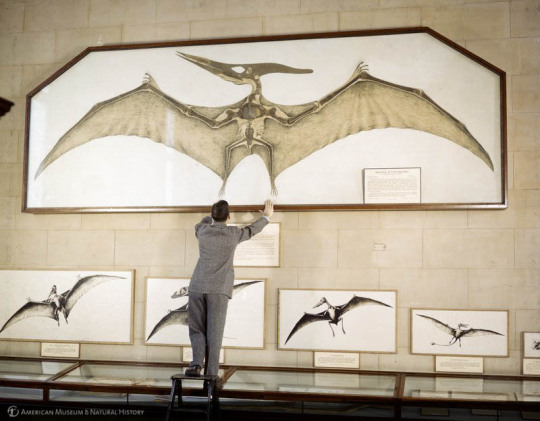
It’s a bird! It’s a plane! It’s… a dinosaur? Nope to all of the above. This Fossil Friday, let’s talk about pterosaurs—the first animals with bones to evolve powered flight. Though they were related to dinosaurs, pterosaurs evolved on a separate branch of the reptile family tree. They ruled the skies for more than 150 million years, evolving into dozens of different species. Some were as small as a paper airplane while others, like Pteranodon pictured here in the Museum's Hall of Late Dinosaurs circa 1940-1960, had a wingspan of more than 20 ft (6 m).
Along with other large pterosaurs, Pteranodon longiceps was first discovered in western Kansas, near a chalk formation called Monument Rocks. Today the region is dry, but at the time this species lived, about 85 million years ago, central North America was covered by a seaway. This large pterosaur likely spent its days flying over the sea. Unlike early species of pterosaurs, Pteranodon and many other Cretaceous-era species didn’t have any teeth. In fact, its genus name means “winged and toothless,” while the second name, longiceps, means “long-headed.”
Today, you can find Pteranodon in the Hall of Vertebrate Origins. We're open daily from 10 am-5:30 pm! Plan your visit.
Photo: Image no. ptc-217 © AMNH Library
#science#amnh#museum#dinosaur#fossil#nature#natural history#paleontology#animals#pterosaur#reptile#did you know#fact of the day#ancient animals#prehistoric animals#vertebrates#fossil friday#pteranodon#archives#flashback friday
667 notes
·
View notes
Text

Fossil predator is the oldest known animal with “saber teeth”
“Vaguely dog-like” animal was one of the oldest-known close cousins of modern mammals
The first true mammals evolved roughly 200 million years ago, during the early days of the dinosaurs. But mammals are the last surviving members of an older group, called the therapsids. At first glance, many therapsids weren’t obviously mammal-like , but they also had subtle features that we recognize in mammals today, like a hole on the sides of their skull for the jaw muscle to attach and structures on their jaw bones that would eventually evolve into mammals' distinctive middle ear bones. In a new paper in the journal Nature Communications, scientists announce the discovery of a fossil therapsid that’s the oldest of its kind, and maybe the oldest therapsid ever discovered: a vaguely dog-like saber-toothed predator. The new fossil, which doesn’t have a species name yet, is a member of a group called the gorgonopsians. “Gorgonopsians are more closely related to mammals than they are to any other living animals,” says Ken Angielczyk, the Field Museum’s MacArthur Curator of Paleomammalogy in the Negaunee Integrative Research Center and a co-author of the paper. “They don’t have any modern descendents, and while they're not our direct ancestors, they're related to species that were our direct ancestors.”...
Read more: Fossil predator is the oldest known animal wi | EurekAlert!
illustration by Henry Sutherland Sharpe

233 notes
·
View notes
Text
i got a fossil >:3

mosasaur tooth >:3
31 notes
·
View notes
Text

THE SECRET LIVES OF DINOSAURS, Unearthing the Real Behaviours of Prehistoric Animals
The new FULL COLOUR book by Dr Dean Lomax & illustrated by me (published by Columbia University Press). The fossilised behaviours in this book will blow your mind!
Out Sept 2025 & available to pre-order on Amazon now! More info: https://cup.columbia.edu/…/the-secret…/9780231558846/
#Art#Painting#PaleoArt#SciArt#SciComm#DigitalArt#Illustration#Dinosaurs#Pterosaurs#Reptiles#Palaeontology#Paleontology#Fossils#PalaeoArt
126 notes
·
View notes
Text
353 notes
·
View notes
